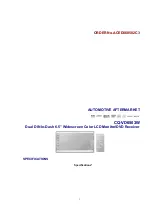
AFW RO System Manual
[3]
Revised 9/09
©Abundant Flow Water System, Inc. 2009
Drain Saddle -
White plastic clamp with quick connect fitting, 2 bolts with nuts, and rubber
seal. Clamps around the drain pipe and connects to the waste water line.
A plastic wrench (for tightening and removing the filter housings) is also included and 2 screws for
attaching the mounting bracket to the mounting location
may
be included.
If you purchased any upgrade kits, please refer to the instructions that came with it for the parts
that should be included with it.
Once you have read and familiarized yourself with these instructions, installation can begin!
Faucet Installation
Locate the installation point for the faucet; you will need a hole at least 1/2” in diameter for the RO
faucet shank. If the sink has a sprayer the RO faucet may be installed in the hole used for the
sprayer, simply disconnect the sprayer and plug the sprayer connection. If the sprayer hole is not
an option you will need to drill a hole or use the facet bracket. If using the faucet bracket, simply
mount with screws (not included) to a sturdy surface, such as a wall or cabinet. If drilling a hole,
determine where it will be located before starting. You will need a 2” flat surface no more than 2”
thick. Ensure the chosen location will not interfere with anything below, and position the faucet so
it will empty into the sink and can swivel freely for convenience. Once you have confirmed your
faucet location you may proceed with drilling the hole in your sink.
Drilling a hole in your sink:
Porcelain, Enamel, or Ceramic on Metal
Be careful when drilling though porcelain, enamel or ceramic sinks, drill slowly to prevent chipping
or scratching, and be sure to wear proper safety equipment to protect yourself.
1.
Mark the center of the hole with a pencil, marker or other marking device
2.
Using a 1/4” masonry bit, carefully (using a slow speed and light pressure) drill a pilot hole
through the sink. If drilling through a ceramic on metal sink, stop when you reach the metal
portion, switch to a 1/4” metal cutting bit and continue.
3.
Continue to enlarge the pilot hole with larger masonry bits (& metal cutting bits if applicable)
until the hole is 1/2".
4.
Clean up any rough or sharp edges.
Stainless Steel or Cast Iron
Be careful when drilling stainless steel or cast iron, drill slowly to prevent scratching, and be sure
to wear proper safety equipment for protection.
1.
Mark the center of the hole with a pencil, marker or other marking device
2.
Using a 1/4” metal cutting bit, carefully drill a pilot hole through the sink.
3.
Continue to enlarge the pilot hole with larger metal cutting bits until the hole is 1/2"
4.
Clean up any sharp edges
Note:
Air gap faucets are required by some local plumbing codes. These faucets require a 1-1/4"







































